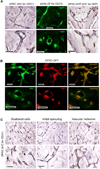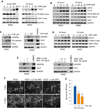Wnt/β-Catenin Signaling Determines the Vasculogenic Fate of Postnatal Mesenchymal Stem Cells
- PMID: 26866635
- PMCID: PMC5338744
- DOI: 10.1002/stem.2334
Wnt/β-Catenin Signaling Determines the Vasculogenic Fate of Postnatal Mesenchymal Stem Cells
Abstract
Vasculogenesis is the process of de novo blood vessel formation observed primarily during embryonic development. Emerging evidence suggest that postnatal mesenchymal stem cells are capable of recapitulating vasculogenesis when these cells are engaged in tissue regeneration. However, the mechanisms underlining the vasculogenic differentiation of mesenchymal stem cells remain unclear. Here, we used stem cells from human permanent teeth (dental pulp stem cells [DPSC]) or deciduous teeth (stem cells from human exfoliated deciduous teeth [SHED]) as models of postnatal primary human mesenchymal stem cells to understand mechanisms regulating their vasculogenic fate. GFP-tagged mesenchymal stem cells seeded in human tooth slice/scaffolds and transplanted into immunodeficient mice differentiate into human blood vessels that anastomize with the mouse vasculature. In vitro, vascular endothelial growth factor (VEGF) induced the vasculogenic differentiation of DPSC and SHED via potent activation of Wnt/β-catenin signaling. Further, activation of Wnt signaling is sufficient to induce the vasculogenic differentiation of postnatal mesenchymal stem cells, while Wnt inhibition blocked this process. Notably, β-catenin-silenced DPSC no longer differentiate into endothelial cells in vitro, and showed impaired vasculogenesis in vivo. Collectively, these data demonstrate that VEGF signaling through the canonical Wnt/β-catenin pathway defines the vasculogenic fate of postnatal mesenchymal stem cells. Stem Cells 2016;34:1576-1587.
Keywords: Angiogenesis; Dental pulp stem cells; Multipotency; Self-renewal; Tissue engineering; Vasculogenesis.
© 2016 AlphaMed Press.
Conflict of interest statement
The authors declare no conflict of interest.
Figures







Similar articles
-
Inverse and reciprocal regulation of p53/p21 and Bmi-1 modulates vasculogenic differentiation of dental pulp stem cells.Cell Death Dis. 2021 Jun 24;12(7):644. doi: 10.1038/s41419-021-03925-z. Cell Death Dis. 2021. PMID: 34168122 Free PMC article.
-
Pulpbow: A Method to Study the Vasculogenic Potential of Mesenchymal Stem Cells from the Dental Pulp.Cells. 2021 Oct 20;10(11):2804. doi: 10.3390/cells10112804. Cells. 2021. PMID: 34831027 Free PMC article.
-
Lipoprotein Receptor-related Protein 6 Signaling is Necessary for Vasculogenic Differentiation of Human Dental Pulp Stem Cells.J Endod. 2017 Sep;43(9S):S25-S30. doi: 10.1016/j.joen.2017.06.006. Epub 2017 Aug 1. J Endod. 2017. PMID: 28778505 Free PMC article.
-
Platelet-derived growth factor receptors regulate mesenchymal stem cell fate: implications for neovascularization.Expert Opin Biol Ther. 2010 Jan;10(1):57-71. doi: 10.1517/14712590903379510. Expert Opin Biol Ther. 2010. PMID: 20078229 Review.
-
Wnt signaling in cardiovascular physiology.Trends Endocrinol Metab. 2012 Dec;23(12):628-36. doi: 10.1016/j.tem.2012.06.001. Epub 2012 Aug 16. Trends Endocrinol Metab. 2012. PMID: 22902904 Review.
Cited by
-
Epigenetic therapeutics in dental pulp treatment: Hopes, challenges and concerns for the development of next-generation biomaterials.Bioact Mater. 2023 May 14;27:574-593. doi: 10.1016/j.bioactmat.2023.04.013. eCollection 2023 Sep. Bioact Mater. 2023. PMID: 37213443 Free PMC article.
-
VEGFR1 primes a unique cohort of dental pulp stem cells for vasculogenic differentiation.Eur Cell Mater. 2021 Mar 16;41:332-344. doi: 10.22203/eCM.v041a21. Eur Cell Mater. 2021. PMID: 33724439 Free PMC article.
-
Role of Heparan Sulfate in Vasculogenesis of Dental Pulp Stem Cells.J Dent Res. 2023 Feb;102(2):207-216. doi: 10.1177/00220345221130682. Epub 2022 Oct 24. J Dent Res. 2023. PMID: 36281071 Free PMC article.
-
Animal Models for Stem Cell-Based Pulp Regeneration: Foundation for Human Clinical Applications.Tissue Eng Part B Rev. 2019 Apr;25(2):100-113. doi: 10.1089/ten.TEB.2018.0194. Epub 2019 Jan 9. Tissue Eng Part B Rev. 2019. PMID: 30284967 Free PMC article. Review.
-
Functional Dental Pulp Regeneration: Basic Research and Clinical Translation.Int J Mol Sci. 2021 Aug 20;22(16):8991. doi: 10.3390/ijms22168991. Int J Mol Sci. 2021. PMID: 34445703 Free PMC article. Review.
References
MeSH terms
Substances
Grants and funding
LinkOut - more resources
Full Text Sources
Other Literature Sources

